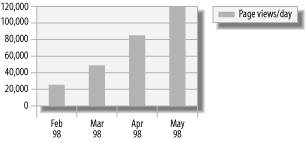Section 23.3. The Slashdot Effect
23.3. The Slashdot Effect
On January 12, 1998, Rob Malda posted a piece on Slashdot titled "Simple Solutions" that he had written, and that he described as "the first of hopefully many Slashdot.org Editorials" (see Appendix D). In this editorial, he challenged Netscape to open source its browser code as the best available alternative for a company losing both money and market share. On January 22, Netscape put out a press release with the headline "Netscape Announces Plans to Make Next-Generation Communicator Source Code Available Free on the Net." The release of Mozilla marks one of the signature events in open source development. It's important to understand what did not happen. No one at either Slashdot or Netscape has ever claimed that Rob Malda's essay had any direct effect on Netscape's decision. Indeed, the complexity of the process and the proximity of the dates suggest that Netscape's decision must have been made well in advance of Rob's editorial. But the proximity of the two eventsand a general lack of understanding about open source at the timecaused mainstream technology media to link the two. Slashdot had been discovered by mass technology media. Several changes began to take hold on Slashdot, and indeed, the effects of those changes are still playing out today. The mainstream technology media took a regular interest in Slashdot, and the mere fact that a story was covered on Slashdot became significant. Ironically, Slashdot seldom has been the originator of a news story, so this interest in Slashdot coverage was largely about watching what other people were watching, an obsession that seems to be a distinctive part of the Internet generation. A peculiar side effect of this "watching the watchers" was that Slashdot became a source of journalistic research. Smart journalists looked for insightful comments, finding stories and ideas in those comments and their authors. Indeed, because Slashdot has always permitted anonymous posting, comments often had the insider's candor that journalists value. An extension of this media interest was the involvement of media figures in Slashdot. Author Jon Katz was working at HotWired at the time, while also researching his book, Geeks. He contacted Rob and Jeff first as part of his research for the book, but more and more because of his genuine interest in Slashdot and the community for which it stood. The result was that Katz became a regular columnist on Slashdot for several years. The reaction to Katz's presence was revealing. Many were impressed with his writings and insights into geek culture, and would quietly send their notes of appreciation to Rob, Jeff, or Jon privately. At the same time, a vocal minority of the audience objected strongly to Katz as an outsider, and posted their views bluntly as comments to any column he posted. When user accounts and customizations arrived on Slashdot, "filter out Jon Katz" was, for a time, the most frequently selected customization. This response was, of course, out of all proportion to anything Katz said or did. Katz is a professional writer, a serious journalist, and had a genuine interest in the geek community. However, he became a symbol of the new crowd that had arrived at Slashdot, readers who were more interested in geek culture than geek technology. Katz became a lightening rod for all the resentment felt by the original core audience, some of whom felt the need to lash out at these "invaders." Slashdot was reaching traffic levels that signified a vastly larger audience than the original Linux and open source enthusiasts and other geeks. On February 9, 1998, the site received its 1 millionth hit. Barely a month later, on March 18, it received its 2 millionth hit. Just a month after that, the site recorded more than 100,000 page views per day. Yet if Slashdot was changing, it was also changing other sites as well. The appearance of a particularly noteworthy story at the top of Slashdot's home page would generate a flurry of discussion. Few stories posted left the front page with fewer than 200 comments, and many stories received in excess of 700 comments. Further, much of the Slashdot audience would descend, simultaneously and en masse, on the site from which the story originated. Many sites were unable to handle this sudden influx of new traffic, and would simply crash under the load. This sequence of eventsthe posting of a story, the rush of traffic to the story's site, and the strain or failure of the site under the loadhas become so notorious that it is now known as "the Slashdot Effect." Indeed the network characteristics of the Slashdot Effect have been worthy of academic study. Stephen Adler at Brookhaven National Laboratory had the first real study of the Slashdot Effect, available online at http://ssadler.phy.bnl.gov/adler/SDE/SlashDotEffect.html. The term Slashdot Effect has entered popular culture; it has an entry in the Oxford English Dictionary's online edition, and Slashdot serves as the answer to a question in the '90s edition of Trivial Pursuit. |
EAN: 2147483647
Pages: 217
